The Best Places to See Wild Elephants in Sri Lanka
Researching where to see elephants in Sri Lanka? Then you’ve come to the right place!
Sri Lanka is one of the few remaining places where you can see hundreds of wild elephants roam free. It’s not certain how many elephants there are in Sri Lanka, but according to the World Animal Protection Organization’s research report on the conditions for elephants used in tourism in Asia, there is an estimated five to six thousand elephants in the wild in Sri Lanka (though this number varies between 3,000 to 7,500 depending on sources).
There are also around 188 elephants in captivity according to the latest 2020 World Animal Protection Asia elephant research report. This means that Sri Lanka has the highest density of wild Asian elephants worldwide.

Sri Lanka offers a tremendous amount of wildlife and biodiversity for its size, and the opportunity to observe elephants in their natural habitat is not to be missed! Read on for more information about the state of elephant conservation in Sri Lanka and where to see wild elephants in Sri Lanka.
Visiting Sri Lanka for the first time? Make sure you read this article on what to know before visiting Sri Lanka!
Elephants in Sri Lanka

The Sri Lankan elephant (Elephas maximus maximus) is one of three recognised subspecies of the Asian elephant, and native to Sri Lanka. Much like their relatives in Africa, the elephants of Sri Lanka form matriarchal herds of more than a dozen individuals. Elephant calves live with their mothers for up to 5 years, after which males disperse and females continue living with the herd.
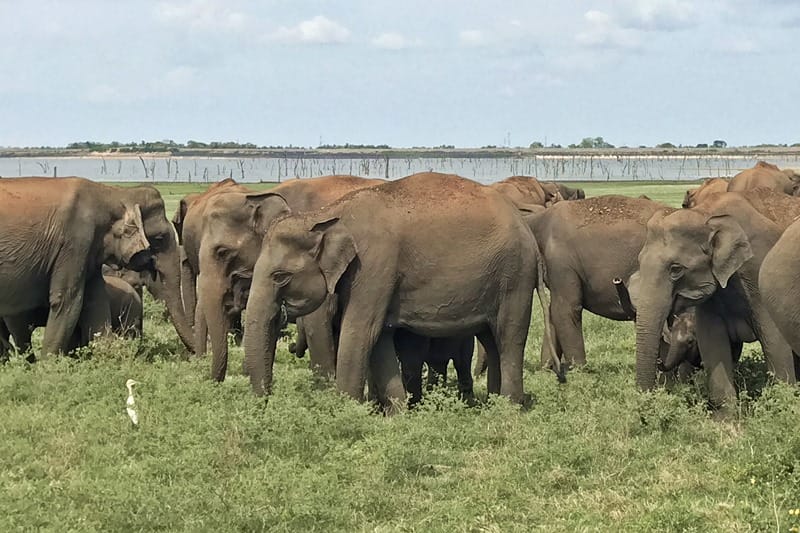
Elephants in Sri Lanka feature smaller ears and a more curved spine when compared with African elephants, and only males have tusks. However, it is rare for a bull elephant in Sri Lanka to have tusks: less than 10% on the island are “tuskers”.
Elephant conservation in Sri Lanka
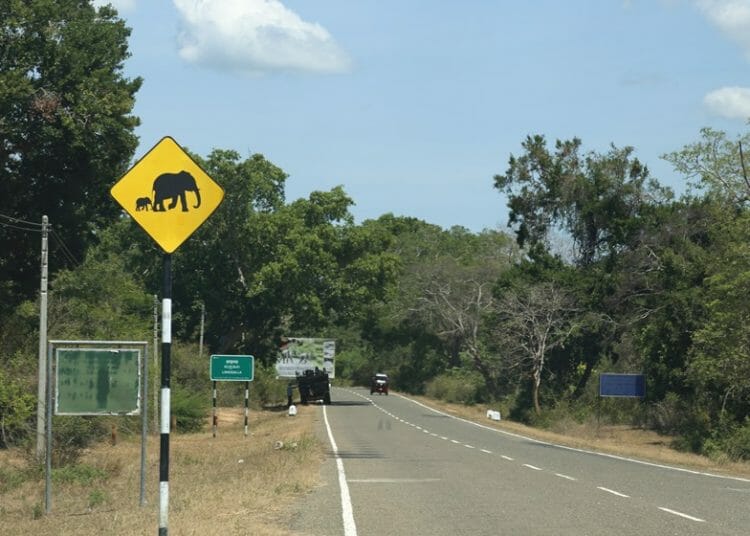
The history of elephants in Sri Lanka dates back thousands of years, when Sri Lanka’s kings owned thousands of them in the royal stables and his subjects were not allowed to capture elephants without his express permission. Later on, Sri Lanka was colonized and the elephant population was quickly depleted from the early 16th to 19th century: much of their habitat in the wet zone was demolished to make way for agricultural land, and wild elephants were also hunted for sport.
It’s thought that the Sri Lankan elephant population has fallen almost 65% since the turn of the 19th century. Today, elephants in Sri Lanka are protected under local laws and killing one carries the death penalty, though the penalty is rarely enforced. One of the major challenges that elephant conservation faces in Sri Lanka is human-elephant conflict, which is increasing due to the conversion of elephant habitat to settlements and permanent cultivation.
A decade ago, Sri Lanka lost around 250 elephants a year. But the numbers have increased in recent years with the deaths now exceeding 400 for the second year in a row. Most of these are due to gun shot injuries from farmers defending their crops, electrocution, home-made jaw bombs and trap guns.
Initially all elephants belonged to the King. In the colonial period the Portuguese and Dutch rulers had a monopoly over the ownership of all domesticated elephants. Later the Dutch allowed the local Chieftains, who captured wild elephants for their colonial masters as tribute, to keep one or two. This is how the tradition of elephant keeping by private owners started in Sri Lanka. Source.
In addition to the wild elephant population in Sri Lanka, more than 100 elephants are domesticated and owned privately by wealthy families as well as by several Buddhist temples around the country. Unlike other countries in Asia, there isn’t an epidemic of “elephant riding camps” as such, though there are attractions do offer elephant riding in Sri Lanka as a tourist activity, and it is not unusual to see elephants being ridden during religious events around the country.

Elephants are revered in Buddhism as well as Sri Lankan culture, and are considered to be a symbol of prosperity. Today, elephants continue to be used to carry Buddhist relics in religious ceremonies and rituals, the most famous being the Kandy Esala Perahera in central Sri Lanka. There are deep religious and cultural roots to these processions, but it was revealed earlier this year that a severely emaciated elephant was being used nightly in the festival.
The Minister of Tourism Development, Wildlife & Christian Religious Affairs later issued a statement and ordered an inquiry into how the elephant was used in the pageant and for actions to be taken against those responsible. He also ordered government veterinarians to inspect the health of all elephants in captivity.
The religious use of elephants in Sri Lanka has its origins in the early period of Buddhism in Sri Lanka. The oldest record of the use of elephants in Buddhist religious processions and festivals in Sri Lanka dates back to 3rd century BCE, when Buddhism was introduced to the Island. The oldest record of the use of elephants to draw a chariot with the Tooth Relic in a procession is from early 14th century CE, centuries prior to the commencement of the Kandy Esala Perahera in the 18th century. Source.
The use of elephants in religion in Sri Lanka is inseparable from its culture and traditions, and a complicated topic to say the least. In an ideal world, no elephants would be shackled and held in captivity and we should continue to work towards this reality.
The good news is that the Department of Wildlife Conservation in Sri Lanka has, and continues to, carry out extensive work to protect the species and mitigate the human-elephant conflict, and these efforts shouldn’t be overlooked. These measures include the establishment of elephant corridors, increasing the extent of protected areas, translocation of troublesome (mostly bull) elephants, erection of electric fencing, and enhancing awareness among local communities. On the other hand, more can always be done.

National parks in Sri Lanka also limit game drives within specific time frames so that the wildlife has some reprieve from visitors and safari jeeps, and sections of Yala National Park close annually so that the animal population can rest and recover. That being said, there are improvements to be made and there are still too many vehicles as well as inexperienced and irresponsible safari jeep drivers roaming around in the parks, harassing elephants and cornering wild animals. There are even multiple incidents where elephants have been pushed to the brink and retaliated by flipping jeeps in the national parks.
The government continues to take action against those provoking the wildlife or illegally capturing and killing elephants: eight people in Sri Lanka were charged in June 2019 in a landmark case where dozens of baby elephants were captured and sold to the wealthy as status symbols. About 40 calves may have been stolen from their herds during a 10-year period and sold for around US$125,000 each. Prior to this, the government arrested five people over killing an elephant and broke up their poaching network in 2017.
Tips for going on a safari in Sri Lanka

As tourism grows in Sri Lanka, as does the number of safari jeeps in these parks. Many safari operators drive like madmen, cornering and chasing wild animals to ensure that their guests have successful animal sightings – but as you can imagine, this is extremely distressing for the wildlife and not safe for passengers either.
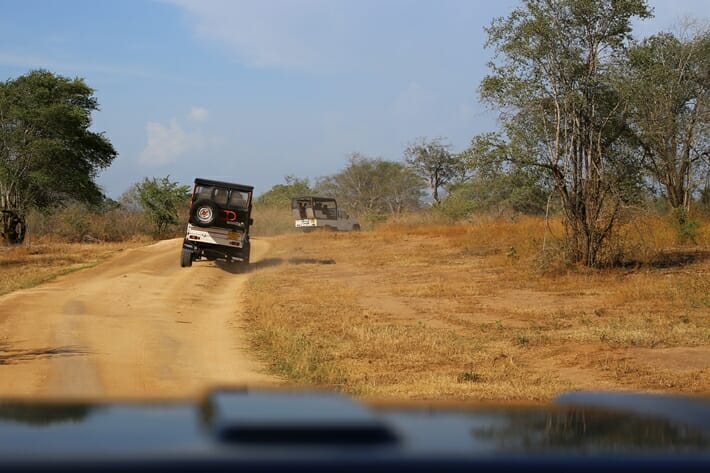
If you are visiting Sri Lanka you absolutely shouldn’t encourage your safari driver to chase or corner animals in national parks. Read more on what not to do in Sri Lanka here. It’s also worthwhile to take the time to read this from the official Yala National Park website:
“The rule of the thumb in visiting a national park is that you must simply blend in and try to be invisible. While you just can’t hide from them, there’s a lot you can do to make sure that the animals can simply ignore you. Each animal has its own personality and the slightest thing can destroy their peace. When you understand their habitat, lifestyle and behavior, you can become a good visitor. Just as much as an irritating and selfish neighbor can drive us wild, destroy our peace and turn us into angry human beings, the slightest thing can upset the equilibrium of animals and that may happen quite unwittingly on your part. This is why educating ourselves is to prepare ourselves for the journey. Avoid any kind of interaction, verbal or through gestures. Did you know even the noise of vehicles seem to affect the feeding habits and personality of elephants, for example? Animals sense who you really are. Be patient and respectful and they will roam freely. Predators can feel mostly under pressure because of photographers, which has huge impact on their hunting, feeding and reproductive habits. Be a spy and never force a photo op on them. Chasing an animal in your vehicle puts them under tremendous pressure and think of having to experience that visitor after visitor, day after day.”
When taking photos of the animals, make use of your camera or phone’s zoom function and keep your distance. Turn the flash off, and stay as quiet as possible (switch your phone to silent or vibrate mode) – you are in their home, after all.
The best place to see elephants in Sri Lanka
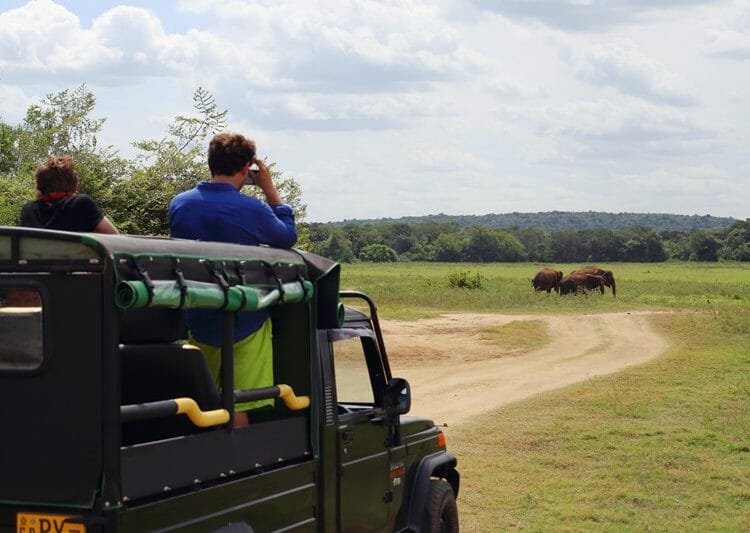
So…what does this mean for visitors to Sri Lanka? I encourage you to make informed choices because the best place to see elephants in Sri Lanka is in their natural habitat.

The Sri Lankan elephant population is now largely restricted to the dry zone in the north, east and southeast of Sri Lanka, and elephants can be seen all year round, sometimes even outside of the national parks when they cross “elephant corridors”.
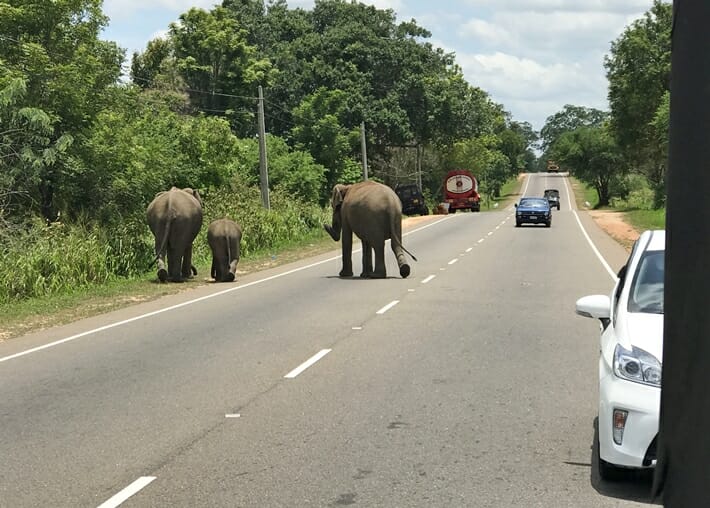
If you’ve come here looking for “where to ride elephants in Sri Lanka”, I hope that the information above has helped to change your mind and that you look into more responsible alternatives, including going on an elephant safari in Sri Lanka. Observing elephants happy and free in the wild is a magical experience, here are some of the best places to see wild elephants in Sri Lanka!
1. Udawalawe National Park

Udawalawe National Park is located in the south of Sri Lanka and is a popular destination for wildlife safaris. It is quite possibly the best place in Sri Lanka to see elephants throughout the year as there are a few hundred elephants within the park (some studies even estimate that there are more than 1000 elephants), and you can frequently witness a herd of females moving or bathing together in the wild.
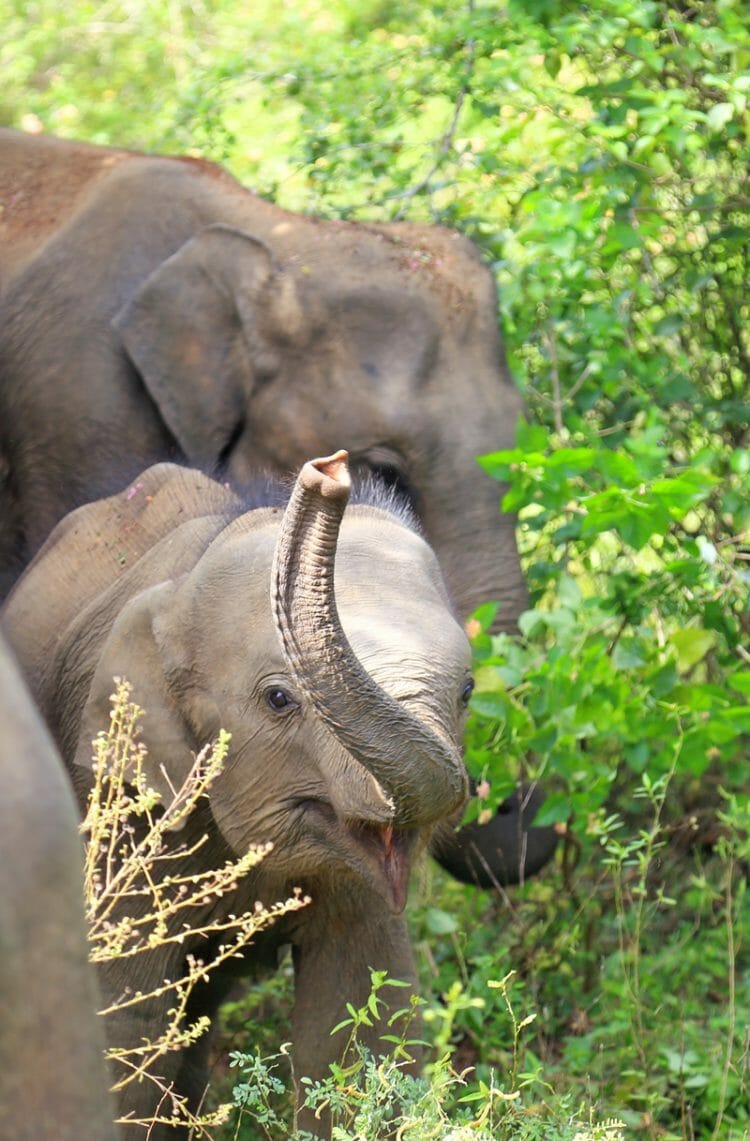
I’ve visited Udawalawe several times and have spotted elephants every single time, including this little babe having a great time with the family. In addition to elephants, Udawalawe is home to tons of crocodiles, eagles, buffalo, peacocks, monkeys, deer and even the occasional leopard. Read more about visiting Udawalawe National Park by clicking here.
2. Yala

Yala National Park is the most visited and second largest national park in Sri Lanka, and only approximately 80 KM away from Udawalawe. It is bordered by Lunugamvehera National Park and Kumana National Park and is located in the south of Sri Lanka. Yala is most well-known for its leopard population, though sightings are never guaranteed.
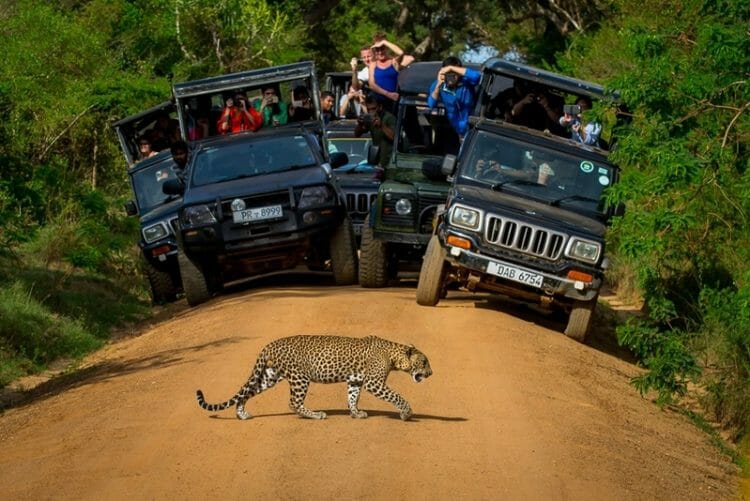
Because it is the most popular national park in Sri Lanka, thousands of people visit every day (mostly Block 1) and Yala is often criticized for the massive volume of jeeps roaming around the park. It is not necessarily an “intimate” wildlife safari experience as you can see from the photo above, and I do recommend visiting one of the other national parks or other lesser-visited blocks within Yala to distribute the tourist load more evenly.
Southern Sri Lanka is not only home to the Udawalawe and Yala National Parks but also incredible beaches and coastal towns. Click here for the ultimate guide to Sri Lanka’s south coast!
3. Minneriya or Kaudulla National Park

Minneriya and Kaudulla National Parks are worth visiting if you are planning on spending time in Sri Lanka’s cultural triangle in the Central Province, approximately 4-5 hours away from Colombo by car. The two parks, though separate, are next to each other and divided by the dense “elephant corridor” jungle between them.
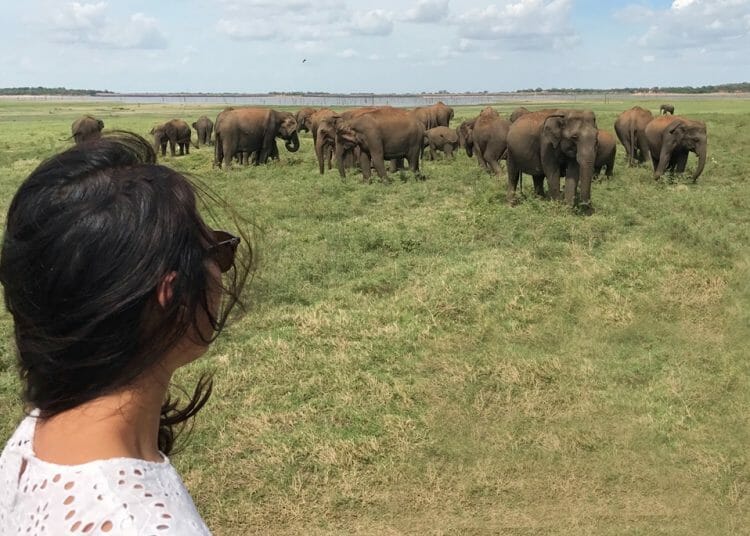
Minneriya and Kaudulla hosts one of the most incredible wildlife events of the year: the annual “Gathering” of Asian elephants. The Gathering is believed to be the largest congregation of Asian elephants in the world and takes place during the dry season from June/July to September when the rivers dry up and the elephants are forced to travel to large reservoirs to bathe, find drinking water and graze on fresh grass.

If you’ve ever wanted to see up to a hundred elephants in the same place then you absolutely have to add Minneriya and Kaudulla to your Sri Lanka itinerary!
4. Wilpattu National Park
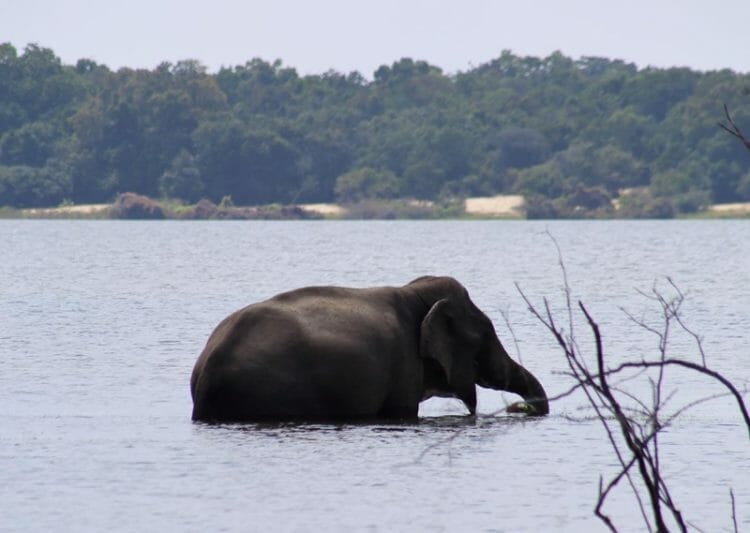
Wilpattu National Park is a park northwest of Colombo, Sri Lanka’s capital. It is one of the oldest and most important protected areas in Sri Lanka. Wilpattu is approximately 3 hours away by car from Colombo, or under an hour from Anuradhapura.
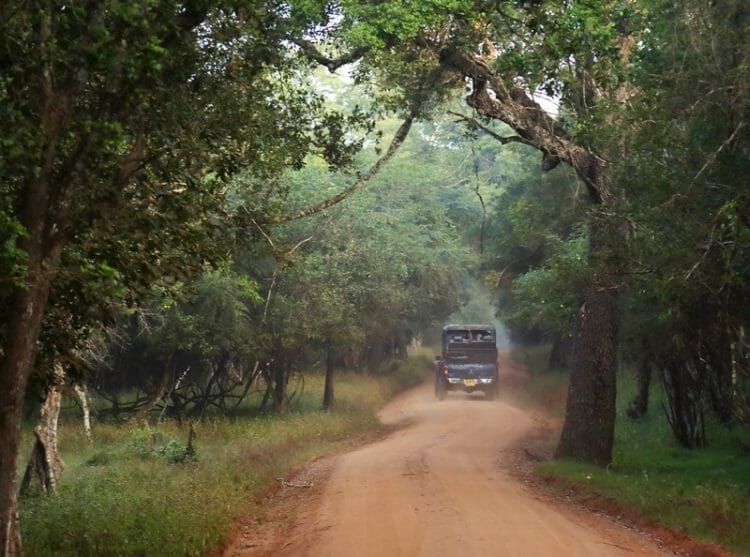
The park is known for its leopard population and receives far fewer visitors than Yala, Udawalawe and even Minneriya/Kaudulla, though it is one of the largest. It is also home to the rare sloth bear, which is highly threatened with less than 1,000 left living in the wild.

As it is a sprawling national park the chances of seeing large herds of elephants is less likely, but you can still spot some wild bull elephants roaming around or taking a bath in the lake! Read on for more information about visiting Wilpattu National Park.
5. Gal Oya National Park
Gal Oya National Park is a small park on the east coast of Sri Lanka, easily accessible as a day trip or overnight stay from Arugam Bay. Gal Oya is one of the more remote and lesser-visited parks in Sri Lanka, which means you are almost guaranteed a peaceful wildlife experience minus the hordes of people and jeeps. Gal Oya also offers visitors the opportunity to go on a boat safari to watch animals from the Senanyake Reservoir.
6. The Udawalawe Elephant Transit Home
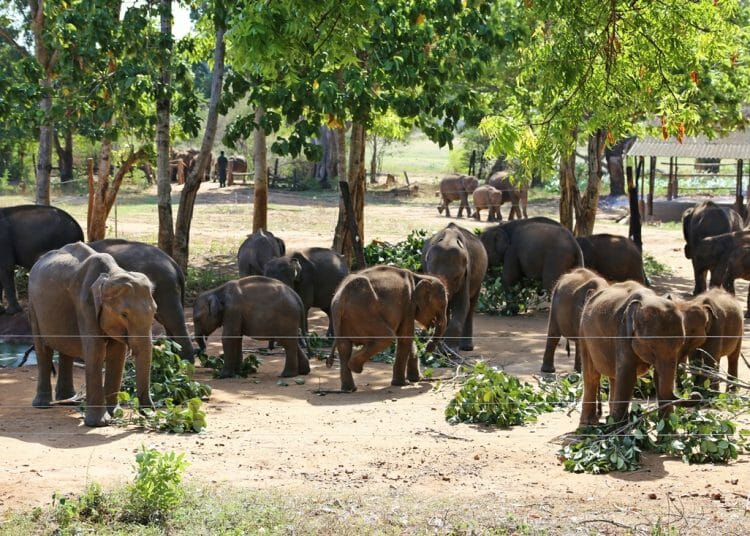
The Elephant Transit Home is probably the best elephant sanctuary in Sri Lanka to visit. The baby elephants here are wild and are rehabilitated before being returned to their natural habitat. It is home to approximately 30-40 rescued orphan elephants in Sri Lanka that are free to roam around.
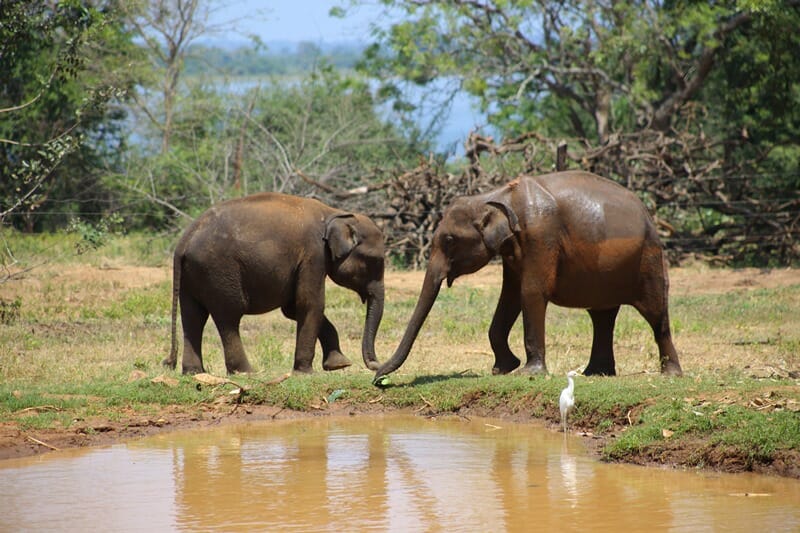
Elephant Transit Home ensures that human contact is kept to a minimum in order to maximize their chance of survival when they are returned to the wild once they turn five years old. According to the organization, more than 110 elephants have been returned back to the national parks around Sri Lanka. You can read more about the work Elephant Transit Home does here.
From the WAP’s Research Report on the conditions for elephants used in tourism in Asia: “A true elephant-friendly venue is purely observational for visitors, where the safety of visitors and wellbeing of elephants is not affected by the need to constantly control the animals.”

Visitors can observe the elephants from a distance during feeding time each day, and you can also walk through the educational center to learn more about the Asian elephant and the threats that challenge their survival. The center does not offer feeding or riding, instead, you can sponsor an elephant and witness its return back into the wild! It is the only venue in Sri Lanka that is included in World Animal Protection’s list of venues with the best welfare conditions.
You might also like: Elephant Sanctuaries, Orphanages and Parks Around the World That You Should Visit
By visiting one of these places to see wild elephants in Sri Lanka and making responsible travel decisions, you can sleep well knowing that you are not contributing to abuse and not playing a part in supporting constant captivity!
Read more about elephants in Sri Lanka here:
- Current Status of Asian Elephants in Sri Lanka
- Elephants in Sri Lanka
- E is for “Endangered”
- Religious Use of Elephants in Ancient Sri Lanka
- Wildlife Viewing Preferences of Visitors to Sri Lanka’s National Parks: Implications for Visitor Management and Sustainable Tourism Planning
- Sri Lanka elephants: ‘Record number’ of deaths in 2019
- First country-wide survey of the Endangered Asian elephant: towards better conservation and management in Sri Lanka
Ready to plan your perfect trip to Sri Lanka? I have plenty of travel tips and recommendations over here.
Pin this for later!


This article contains affiliate links. If you choose to book using these links, I will earn a small commission at no extra cost to you. Thank you for supporting my website by using these links.
Enjoyed reading this article? Subscribe to the mailing list!
* Unsubscribe at any time. Your e-mail address will only ever be used to send the occasional Yoga, Wine & Travel newsletter.



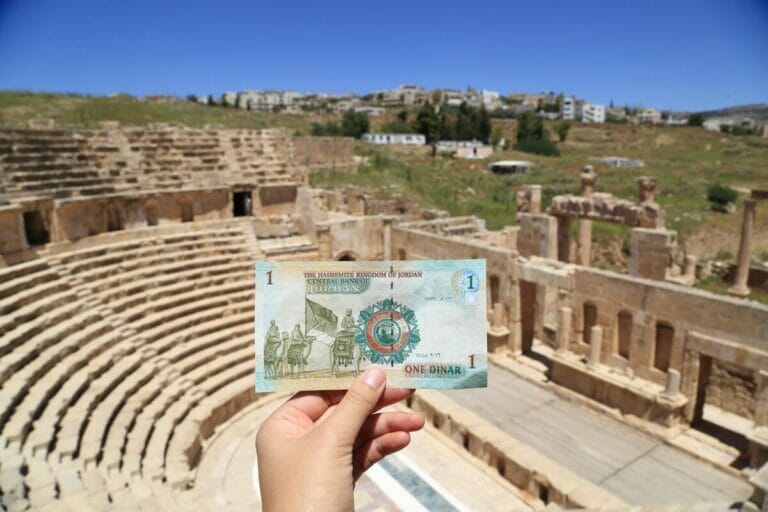


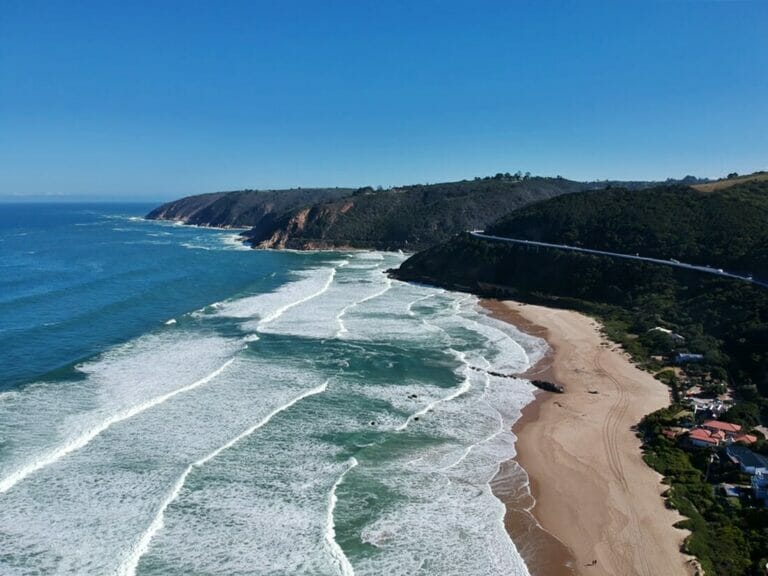


Thank you so much for the info , i am heading to Sri Lanka in March and using your one week Sri itinerary as a guide but will add the train journey for part of the trip. Would you suggest us going south for the elephants over the golden triangle in Kadulla etc?
Hi Irene, wonderful to hear that you found my guides helpful in planning your trip! Yes if you are visiting in March I would head to Udawalawe instead of Minneriya/Kaudulla. Hope that helps!
ah wow! I’m so putting these places on my bucketlist. Elephants are amazing
Hope you make it over to Sri Lanka to see these beautiful pachyderms!